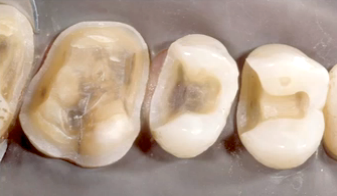Techniques & Materials
Four Guidelines for Direct Resin
By Frank Spear on August 1, 2013 | 9 comments There can be confusion for clinicians when trying to decide if direct composite is the adequate solution to treat patients, or if dong an indirect restoration will ensure the best chances of a predictable result.
There can be confusion for clinicians when trying to decide if direct composite is the adequate solution to treat patients, or if dong an indirect restoration will ensure the best chances of a predictable result.
Especially in higher risk posterior areas, when we think about direct versus indirect restorations we want to pay very close attention to what the literature suggests will be a predictable result. There are four guidelines that I will evaluate in order to determine if a direct restoration will yield the most successful results.
This is not to say that direct composite can't be done if these criteria aren't met. However, if these criteria were met there would be very little reason to not use a direct restoration.
- Gingival margins in enamel: When the gingival margins of the proximal box are in the enamel, we get less recurrent caries in direct resin restorations as opposed to when the proximal box is all dentin. One of the problems with direct resin is shrinkage; when we cure it the composite shrinks and risks micro leakage. However, if there is enamel to etch and bond to the risk of leakage is significantly reduced.
- Isthmus is less than half the intercuspal width: The smaller the composite, the more tooth structure remains to resist functional forces and flexure. When the isthmus is less than half the intercuspal width, it means the cusps retain a significant resistance to flexure, which reduces the fatigue placed on the bond to the restoration. The wider the composite gets, the weaker the cusps become, meaning cuspal flexure becomes an increasing problem, this flexure can result in bond failure and the introduction of leakage.
- Ability to isolate and visualize placement: If you can't isolate, bond and visualize your placement, there is no way to do a predictable direct composite restoration. When you can't visualize and isolate, you should opt for a more forgiving material, such as amalgam or consider an indirect restoration that doesn't require perfect isolation such as a cemented restoration.
- Occlusion supported by enamel: Another factor that can add to the predictability of direct composites is if the occlusal contacts are on the actual tooth structure itself. This minimizes the risk of overloading the composite, reducing the risk of fracture and wear.
Comments
August 1st, 2013
August 1st, 2013
August 2nd, 2013
August 7th, 2013
August 7th, 2013
August 17th, 2013
December 21st, 2013
March 13th, 2015
March 13th, 2015